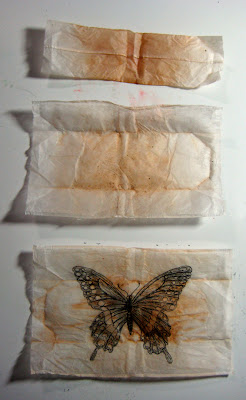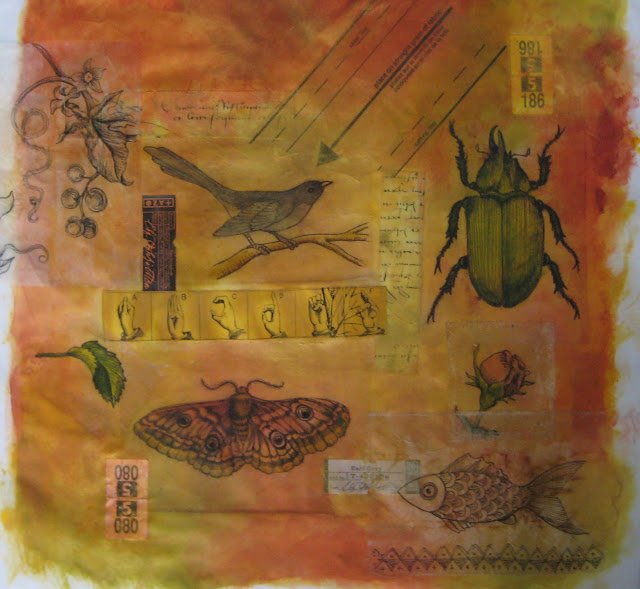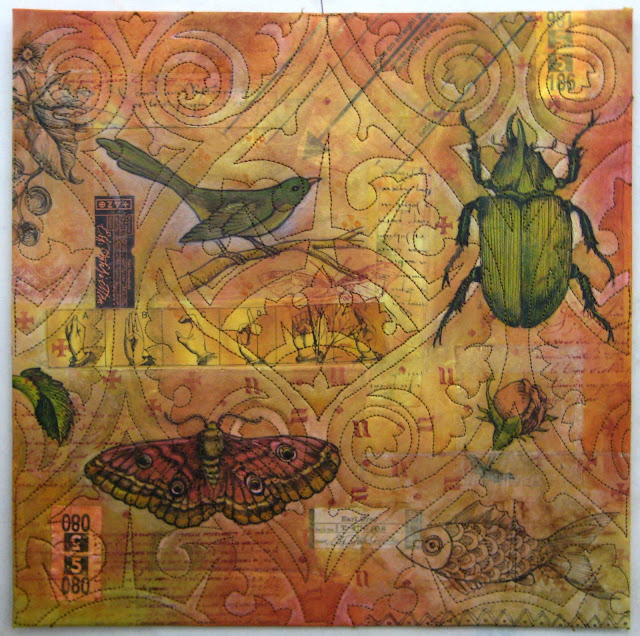 Drawing on a tea bag.
Drawing on a tea bag.1. After steeping your tea, set tea bag on the counter to dry and enjoy that fabulous warm cuppa tea. Black tea has tannins which are what create those lovely brown stains.
2. When the tea bag is dry carefully remove the staple, unfold top of bag and shake out the dried tea leaves into the trash or compost bin.
3. Gently, pull seam apart down the length of the bag and fold out flat, brushing away any leaves that may be clinging to the paper. You can iron your tea bags if you want them nice and smooth before drawing.
4. Place the tea bag on top of a hand drawn design or lay it over a printed image. You should be able to faintly see the drawing through the tea bag. Trace your design onto the tea bag with a permanent ink marker, and fill in the details.
5. Now you can use this tea bag to collage onto paper or fabric using matte acrylic gel medium.
6. Using acrylic gel medium, paint the fabric where you will be putting the tea bag a tad larger than the size of the tea bag paper.
7. Press the tea bag onto the wet medium and brush more medium over the top of the tea bag sealing it to your fabric.
8. After the medium dries you can glaze over the drawing with layers of transparent paint, use colored pencils, or leave it as is in all its tea stained glory!
Making Illustrated Document No. 1
 I painted a piece of fabric with yellow and ocher colors to use as a base. The drawings were done on tea bags. I drew on the bags with a fine tip permanent marker and used matte medium to collage them on the fabric. I also adhered a couple tags from the tea and those tags that come stapled to your dry cleaning. There is also some fabric ran through a xerox machine several years ago and a piece of a sewing pattern tissue.
I painted a piece of fabric with yellow and ocher colors to use as a base. The drawings were done on tea bags. I drew on the bags with a fine tip permanent marker and used matte medium to collage them on the fabric. I also adhered a couple tags from the tea and those tags that come stapled to your dry cleaning. There is also some fabric ran through a xerox machine several years ago and a piece of a sewing pattern tissue. I added text and marks for background patterns with rubber stamps inked with Tsukineko Inks. Then I fused the fabric to a 12 inch square of wool felt. I folded the edges over and fused them to the back of the felt. This makes a nice flat and flexible piece for stitching.
I added text and marks for background patterns with rubber stamps inked with Tsukineko Inks. Then I fused the fabric to a 12 inch square of wool felt. I folded the edges over and fused them to the back of the felt. This makes a nice flat and flexible piece for stitching. I was torn with how I should quilt this since the over all look began to feel like an aged document. I thought if I quilted around the elements like my first inclination would be, that it would be too predictable a thing to do, so I decided to take a risk and do quilting that was totally unrelated to the design of the piece but related to the aesthetic of the piece.
I was torn with how I should quilt this since the over all look began to feel like an aged document. I thought if I quilted around the elements like my first inclination would be, that it would be too predictable a thing to do, so I decided to take a risk and do quilting that was totally unrelated to the design of the piece but related to the aesthetic of the piece. I found a gothic tile design that I modified into a pattern that could be stitched. After quilting the design I used a copper paint stick and shaded in some of the pattern. Then the bird and butterfly started to feel lost in the design so I pulled out some colored pencils and added a little color.
I found a gothic tile design that I modified into a pattern that could be stitched. After quilting the design I used a copper paint stick and shaded in some of the pattern. Then the bird and butterfly started to feel lost in the design so I pulled out some colored pencils and added a little color.The total list of materials and techniques is:
white cotton fabric, teabags drawn on with permanent ink pen, tea labels, dry cleaning tags, sewing pattern, fabric with xeroxed imagery, textile paint, rubber stamps, Tsukineko inks, Shiva paint sticks, colored pencils, machine quilted on wool felt.
comments:
- Anonymous said...
- I love this piece of art....Wonderful imagery! I am amazed by your creative ideas and appreciate your willingness to share. Could you tell me how you transfered the tile design to the surface of the paper quilt? thank you so much....
Susan
- judy coates perez said...
- Susan,
I traced the design onto tracing paper. (seen in the small photo) I cut a few small holes in the paper away from stitching lines and used scotch tape to stick the paper to the quilt by placing tape over the holes. I stitched through the paper and the quilt and then tore it away when I was done.
- Carol Sloan said...
- Judy,
I was working on the paper quilt that I posted a pic of, and had drawn out my quilting design on regular tracing paper. I tried the design on a random quilt sandwich (to make sure it was a "do-able" design).I had a lot of problems with the stitches pulling up or out when I removed the tracing paper. I tried a small design with some paper specically made for sewing a quilting design and another with the kimwipes. The kimwipes did the best but I still had a small amount of pulling on the stitches. How did you do yours/did you have the same problem? I took pics so that I could post a "hey, look ...you really don't want to do this" posting...if you have a second to help, I'd sure appreciate it.
Thanks - judy coates perez said...
- Carol,
I think my machine does a pretty tight stitch to begin with. The smaller the stitches, the more it is going to perforate the paper making it tear easier. There is a lighter weight tracing paper that comes on a roll, architects use it, and it will tear easier, also I am sure you realize now you to have to pull the paper away gently. Your thread tension may be a little loose as well, try tightening it and see if that helps.
- Ricë said...
- i love this--fabulous! how do the colored pencils work for you? i've tried everything to set them, to keep them from smearing on fabric. you've probably addressed this somewhere else already--
- judy coates perez said...
- Because the tea bags are paper the colored pencil stays on better than on fabric. I have never actually had a problem with them smearing, but you could try painting a light coat of fabric medium over them or give them a hit of artist spray fix.

Thank you for the repost - its always good to go back to interesting techniques like this to refresh our memories. When I first read it I was not ready to experiment, so this is a timely reminder of a technique I very much want to learn!
ReplyDeleteI absolutely love your quilted tea bag piece! Just gorgeous - makes me want to play with my sewing machine again (and some tea bags which I have been saving!)
ReplyDeleteThis is a beautiful piece! This may be exactly what I need on something I am working on right now. Thanks for the "rerun"!
ReplyDeleteThis was one of my favorite covers from QA magazine! Thanks for sharing your process!
ReplyDelete